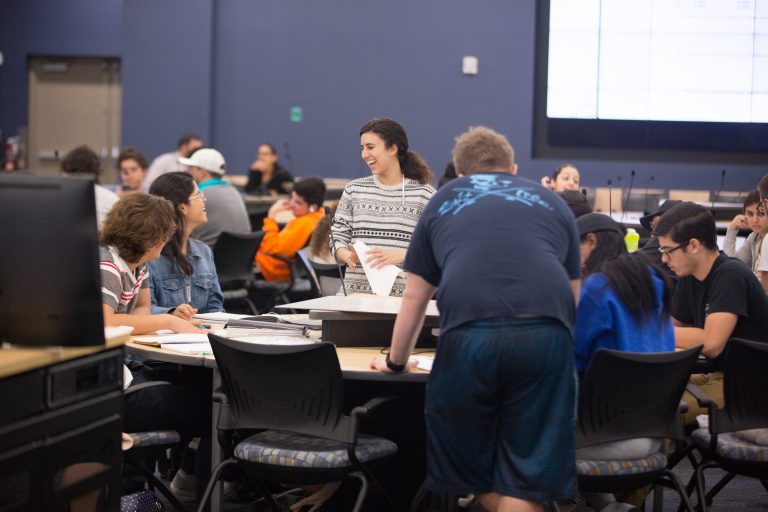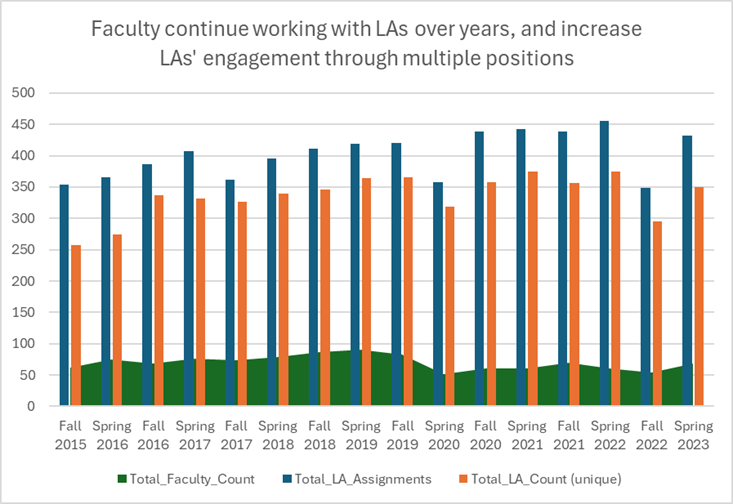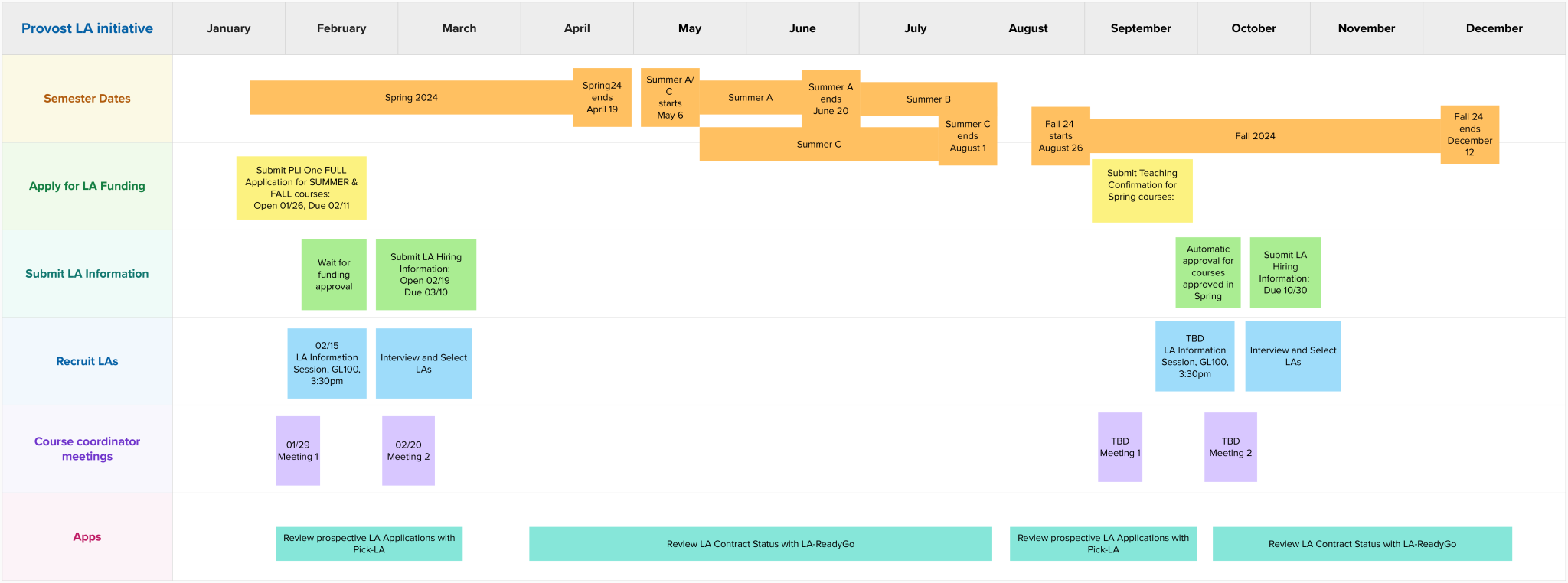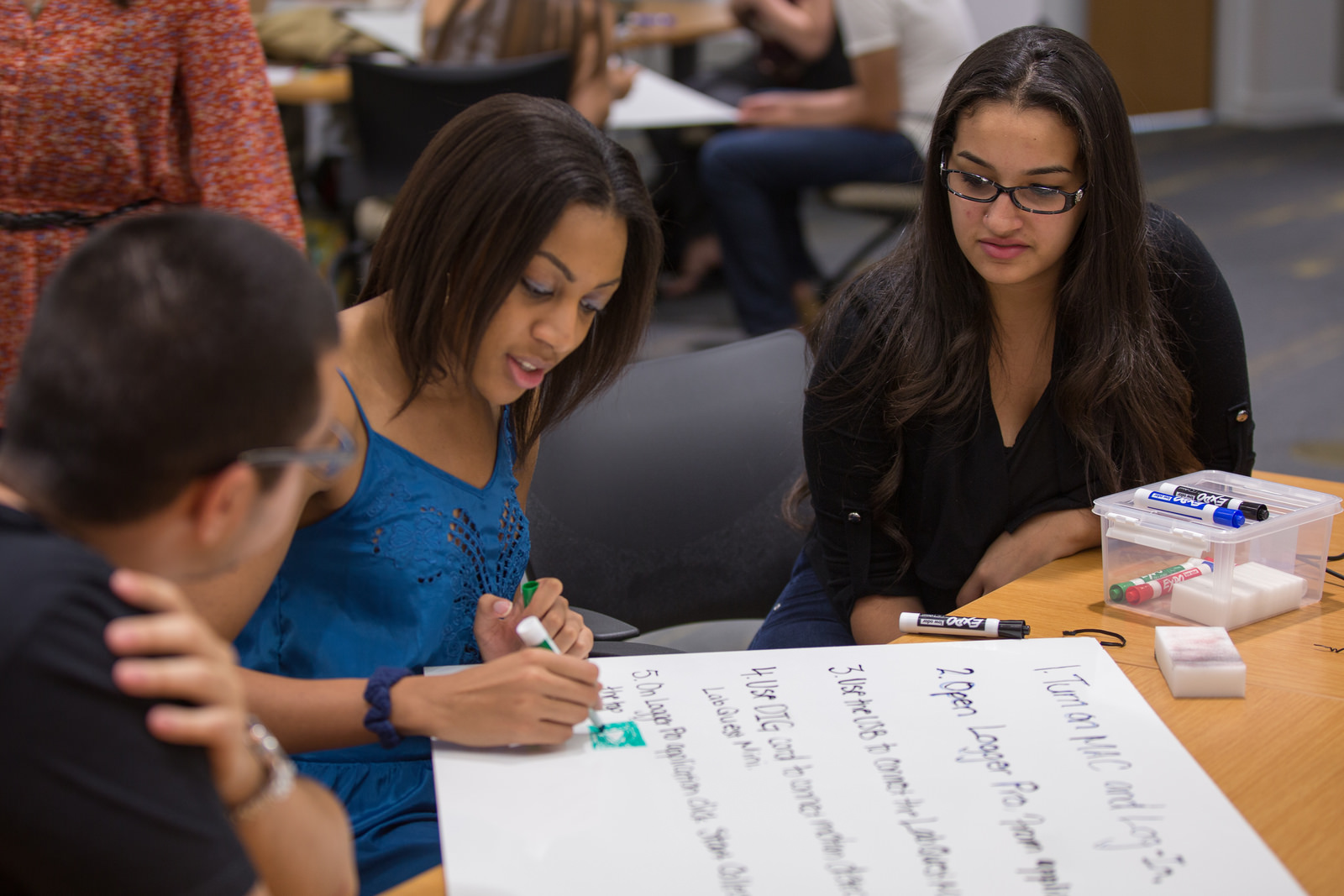Faculty Guide

1. Provost LA Initiative
2. How to secure funding for LAs
3. How to recruit LAs
4. Working with LAs: Best Practices
5. Policies and Procedures
6. Further Exploration
Overview
Learning Assistants (LAs) are undergraduate students who facilitate collaborative peer learning by engaging students in the articulation of scientific ideas during group work in class. In Fall 2015, the provost announced a university-wide initiative to support faculty by allocating funding for Learning Assistants (LAs) in their courses. Starting with 120 LAs earlier, the Provost LA initiative (PLI) expanded to support approximately 400 LAs every semester, working with STEM faculty. The purpose of the initiative is to support the implementation of evidence-based STEM teaching to create inclusive and equitable learning environments at FIU, broaden the participation of underrepresented groups in STEM and subsequently contribute to creating a diverse STEM workforce.
Multiple research studies and numerous projects have demonstrated the effectiveness of having LAs in STEM courses, in improving student success, and creating a lasting impact on LAs themselves (See studies in the Further Exploration section below). Housed in the STEM Transformation Institute (STEM-TI), the FIU LA Program administers all Learning Assistant activities on campus. It supports faculty and equips Learning Assistants to fully engage in and benefit from their roles. The Provost LA Initiative provides faculty with LA funding to encourage implementation of innovative STEM teaching. Faculty submit course proposals describing how LAs could support student learning in their courses. Courses aligns with the LA model [1] allocated funding based on specific criteria. Since 2015, numerous STEM faculty have demonstrated a strong commitment to finding innovative instructional methods through integrating LAs in their classrooms (see chart above). This commitment has significantly contributed to the success of STEM students at FIU.

Being an LA is a unique experience available to undergraduate students at FIU.
How does the Provost LA Initiative (PLI) work?

Things to keep in mind:
-
- Submit a full application once a year in Spring (PLI One Faculty Application, laprogram.fiu.edu/faculty). The course approval carries out to the entire year, no need to provide any information but the teaching confirmation in early Fall.
- The busy LA hiring months are February/March and September/October
- Ask students and LAs to apply on https://laprogram.fiu.edu/apply
- Use Pick-LA to review prospective LA application. Use LA-ReadyGo to check LA contract status. Same access key shared in email. Please keep confidential to protect student information.
Useful Info for Faculty and Common Questions & Answers
Are you a course coordinator?
Course coordinators for large courses generally apply for LA funding on behalf of their team. If you are part of an LA coordinated course, please make sure you communicate with your course coordinator to ensure that they applied on behalf of your course/section. If you are not sure whether you course is coordinated or are interested in coordinating a course, please contact us at laprogram@fiu.edu for further instructions. Course coordinators are expected to attend LA coordinator meetings with the LA program.
I am applying for LA funding for a Summer or/and Fall course. What information do I need to have ready to submit a PLI Application? Also where is the link?
You will find the link at https://laprogram.fiu.edu/faculty. You will need the course Information for the course you will be teaching or anticipate teaching, including course format, the number of sections anticipated and the expected enrollment for these sections. Every spring, faculty are asked to provide data assessing their instructional methods, the successes and challenges. The application has to include data related to student experiences, LA practices and/or your teaching practices. You will need to upload a document that includes item #1 on the list below, and at least 1 more item from #2 through #5. Most likely you already have all of the needed evidence; consider what you have recently completed for the teaching evaluation project, the gateway survey, teaching awards or any CAT workshop you have participated in, surveys you have conducted in class, etc. Here are the options:
1. Surveys of student experiences in class, including their interactions with LAs. Feel free to upload the gateway survey report or any other survey. It will help us understand how students interact with your LAs and provide you with support in the case that modifications are needed. Required.
Submit at least one item from #2 through #5:
2. Other data you would like to share; for example, if you have already uploaded evidence in your annual teaching evaluation (i.e., Data Sources: Student, Peer and Self elements)
3. Any data related to mid-semester surveys.
4. Data about passing rates or learning gains on exams or concept inventories.
5. Data about the LAs themselves to see what they think of the experience and working with you as an instructor. The LA program can provide you with a short survey template if needed.
**If this is your first time applying through the PLI or if you haven’t worked with LAs at all until now, please contact the LA Program for a consultation about assessment.
I coordinate a multi-section course that includes additional faculty. I will apply on their behalf. What data should I provide?
Item #1 on the list above. Please share an aggregate of the data (such as the gateway survey) with all sections, if available.
I am not sure I can integrate LAs into my class.
If you lecture more than 50% of your class time, your class may not be a good fit for having LAs, as they need to interact with students. LAs should spend time interacting with students in class, and cannot be assigned grading or only outside class sessions.
What is the teaching confirmation?
Effective Spring 2023, faculty submit a full PLI Application in Spring (aka full PLI cycle) and only a teaching confirmation in Fall (aka quick PLI cycle). Continuation of funding is contingent upon alignment with LA Model practices and with availability of funds. Please make sure to carefully read LA Program emails.
Further Exploration and References
[1] Valerie K. Otero, “Nationally scaled model for leveraging course transformation with physics teacher preparation,” in Recruiting and Educating Future Physics Teachers – Case studies and effective practices, Cody Sandifer and Eric Brewe, Eds. American Physical Society, 2015.
[2] Anthony P. Barrasso and Kathryn E. Spilios, “A scoping review of literature assessing the impact of the learning assistant model,” International Journal of STEM Education, 8(1), p. 12, 2021, doi: 10.1186/s40594-020-00267-8.
[3] Hagit Kornreich‐Leshem, Rocio Benabentos, Zahra Hazari, Geoff Potvin, and Laird Kramer, “The cognitive and affective roles of learning assistants in science, technology, engineering, and mathematics college classrooms: An exploration of classroom experiences and students’ metacognitive awareness and disciplinary identity,” Science Education, 106(3), pp. 545–572, 2022, doi: 10.1002/sce.21703.
[4] Eleanor W. Close, Jessica Conn, and Hunter G. Close, “Becoming physics people: Development of integrated physics identity through the Learning Assistant experience,” Physical Review Physics Education Research, 12(1), p. 010109, 2016, doi: 10.1103/physrevphyseducres.12.010109.
[5] Renee Michelle Goertzen, Eric Brewe, Laird H. Kramer, Leanne Wells, and David Jones, “Moving toward change: Institutionalizing reform through implementation of the Learning Assistant model and Open Source Tutorials,” Physical Review Special Topics – Physics Education Research, 7(2), p. 020105, 2011, doi: 10.1103/physrevstper.7.020105.
[6] Nadia Sellami, Shanna Shaked, Frank A. Laski, Kevin M. Eagan, and Erin R. Sanders, “Implementation of a Learning Assistant Program Improves Student Performance on Higher-Order Assessments,” CBE-Life Sciences Education, 16(4), p. ar62, 2017, doi: 10.1187/cbe.16-12-0341.
[7] R. Talbot, Hartley L, K. Marzetta, and B. S. Wee, “Transforming undergraduate science education with learning assistants: Student satisfaction in large‐enrollment courses,” Journal of College Science Teaching, (44), pp. 24–30, 2015.
[8] Jessica L. Alzen, Laurie S. Langdon, and Valerie K. Otero, “A logistic regression investigation of the relationship between the Learning Assistant model and failure rates in introductory STEM courses,” International Journal of STEM Education, 5(1), p. 56, 2018, doi: 10.1186/s40594-018-0152-1.
[9] Jessica L. Alzen, Laurie Langdon, and Valerie K. Otero, “The Learning Assistant model and DFW rates in introductory physics courses,” pp. 36–39, 2018, doi: 10.1119/perc.2017.pr.004.
[10] Laken M. Top, Sarah A. Schoonraad, and Valerie K. Otero, “Development of pedagogical knowledge among learning assistants,” International Journal of STEM Education, 5(1), p. 1, 2018, doi: 10.1186/s40594-017-0097-9.
